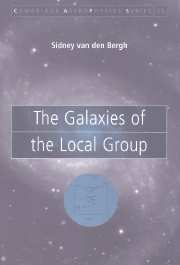Book contents
- Frontmatter
- Contents
- Preface
- 1 Introduction
- 2 Local Group membership
- 3 The Andromeda galaxy (M31)
- 4 The Milky Way system
- 5 The Triangulum galaxy (M33)
- 6 The Large Magellanic Cloud
- 7 The Small Magellanic Cloud
- 8 The elliptical galaxy M32 (= NGC 221)
- 9 The irregular dwarf galaxy NGC 6822
- 10 The starburst galaxy IC 10
- 11 Faint dwarf irregular galaxies
- 12 Spheroidal galaxies
- 13 The most luminous dwarf spheroidal galaxies
- 14 Dwarf spheroidals in the Andromeda subgroup
- 15 Faint dwarf spheroidals
- 16 The outer fringes of the Local Group
- 17 Intergalactic matter in the Local Group
- 18 Dynamical and physical evolution
- 19 Properties of the Local Group
- 20 Conclusions
- Glossary
- Bibliography
- Object Index
8 - The elliptical galaxy M32 (= NGC 221)
Published online by Cambridge University Press: 22 August 2009
- Frontmatter
- Contents
- Preface
- 1 Introduction
- 2 Local Group membership
- 3 The Andromeda galaxy (M31)
- 4 The Milky Way system
- 5 The Triangulum galaxy (M33)
- 6 The Large Magellanic Cloud
- 7 The Small Magellanic Cloud
- 8 The elliptical galaxy M32 (= NGC 221)
- 9 The irregular dwarf galaxy NGC 6822
- 10 The starburst galaxy IC 10
- 11 Faint dwarf irregular galaxies
- 12 Spheroidal galaxies
- 13 The most luminous dwarf spheroidal galaxies
- 14 Dwarf spheroidals in the Andromeda subgroup
- 15 Faint dwarf spheroidals
- 16 The outer fringes of the Local Group
- 17 Intergalactic matter in the Local Group
- 18 Dynamical and physical evolution
- 19 Properties of the Local Group
- 20 Conclusions
- Glossary
- Bibliography
- Object Index
Summary
Introduction
The compact E2 galaxy M32 is the closest companion to the Andromeda galaxy. The projected separation of these two objects on the sky is only 24′ (5.3 kpc). It was first suggested by Schwarzschild (1954) that the tides induced by M32 were responsible for the distortion of the spiral structure of M31 and the warping of its disk. Later Faber (1973) noted that CN and Mg absorption in M32 was stronger than might have been expected from its luminosity (i.e., it has the metallicity usually seen in significantly more luminous objects). She therefore proposed that M32 was initially a much more luminous galaxy had suffered severe tidal truncation by M31. The very compact object NGC 4486B, which is a companion to M87, appears to be another example of a similar type of galaxy that has suffered tidal truncation. The absence of globular clusters in M32 probably also results from its outer swarm of globulars being stripped off by tidal forces. [The innermost M32 globulars might have been sucked into its massive semi-stellar nucleus by tidal friction (Tremaine, Ostriker & Spitzer 1975).] It would be interesting (M. Mateo 1999, private communication) to study the distribution of globular clusters in NGC 4486B, which, like M32, is thought to have suffered severe tidal truncation.
Kormendy (1985) and Ziegler & Bender (1998) have pointed out that M32 is quite a unique object and that there are very few other ellipticals like it. Compared to other dwarf galaxies having similar values of MV, its central surface brightness is four orders of magnitude higher, and its core radiusrc is three orders of magnitude smaller.
- Type
- Chapter
- Information
- The Galaxies of the Local Group , pp. 163 - 169Publisher: Cambridge University PressPrint publication year: 2000

